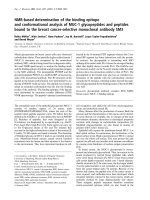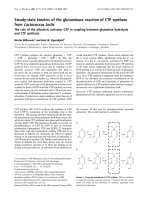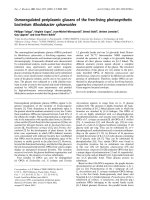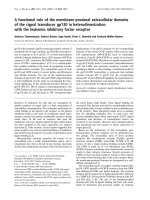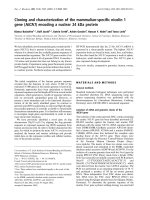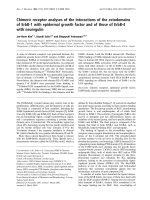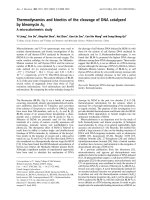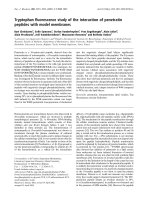Báo cáo Y học: Osmoregulated periplasmic glucans of the free-living photosynthetic bacterium Rhodobacter sphaeroides doc
Bạn đang xem bản rút gọn của tài liệu. Xem và tải ngay bản đầy đủ của tài liệu tại đây (394.26 KB, 9 trang )
Osmoregulated periplasmic glucans of the free-living photosynthetic
bacterium
Rhodobacter sphaeroides
Philippe Talaga
1
, Virginie Cogez
1
, Jean-Michel Wieruszeski
2
, Bernd Stahl
3
,Je
´
ro
ˆ
me Lemoine
1
,
Guy Lippens
2
and Jean-Pierre Bohin
1
1
Unite
´
de Glycobiologie Structurale et Fonctionnelle, CNRS UMR8576, Universite
´
des Sciences et Technologies de Lille,
Villeneuve d’Ascq, France;
2
CNRS UMR8525, Institut de Biologie de Lille, Institut Pasteur de Lille, France;
3
Milupa GmbH & Co.
KG, Research International, Friedrichsdorf, Germany
The osmoregulated periplasmic glucans (OPGs) produced
by Rhodobacter sphaeroides, a free-living organism, were
isolated by trichloracetic acid treatment and gel permeation
chromatography. Compounds obtained were characterized
by compositional analysis, matrix-assisted laser desorption
ionization mass spectrometry and nuclear magnetic
resonance. R. sphaeroides predominantly synthesizes a cyclic
glucan containing 18 glucose residues that can be substituted
by one to seven succinyl esters residues at the C
6
position of
some of the glucose residues, and by one or two acetyl resi-
dues. The glucans were subjected to a mild alkaline treat-
ment in order to remove the succinyl and acetyl substituents,
analyzed by MALDI mass spectrometry and purified
by high-performance anion-exchange chromatography.
Methylation analysis revealed that this glucan is linked by 17
1,2 glycosidic bonds and one 1,6 glycosidic bond. Homo-
nuclear and
1
H/
13
C heteronuclear NMR experiments
revealed the presence of a single a-1,6 glycosidic linkage,
whereas all other glucose residues are b-1,2 linked. The
different anomeric proton signals allowed a complete
sequence-specific assignment of the glucan. The structural
characteristics of this glucan are very similar to the previ-
ously described OPGs of Ralstonia solanacearum and
Xanthomonas campestris, except for its different size and the
presence of substituents. Therefore, similar OPGs are syn-
thesized by phytopathogenic as well as free-living bacteria,
suggesting these compounds are intrinsic components of the
Gram-negative bacterial envelope.
Keywords: periplasm; osmoregulation; cyclic glucans.
Osmoregulated periplasmic glucans (OPGs) appear to be
general constituents of the envelope of Gram-negative
bacteria [1]. Their abundance in the periplasmic space is
the greatest when the medium osmolarity is very low. Under
these conditions, OPGs can represent between 5 and 10% of
the cellular dry weight. These compounds play an important
role in the interaction with specific plant hosts; in Sinorhiz-
obium meliloti [2] and Bradyrhizobium japonicum [3] they are
essential for nitrogen fixation; and in Agrobacterium tume-
faciens [4], Pseudomonas syringae [5,6], and Erwinia chry-
santhemi [7] for the development of plant disease. In this
latter case, experiments in which OPG deficient mutants
were coinoculated with wild-type bacteria have established
that OPGs must be present in the periplasmic space of the
bacteria to enable growth in the plant host [7]. However,
beyond this functional homology, and the fact that glucose is
the sole monosaccharide present, OPGs from various origins
display an unexpected structural diversity. This variation
occurs at two levels: the glucose backbone organization, and
the absence or the presence of various substituents.
Four families of OPGs can now be distinguished
(a) OPGs of Escherichia coli, P. syringae and Erwinia
chrysanthemi appears to range from six to 13 glucose
residues [8,9]. The structure is highly branched, the back-
bone consisting of b-1,2 linked glucose units to which the
branches are attached by b-1,6 linkages. The OPGs of
E. coli are highly substituted with sn-1-phosphoglycerol,
phosphoethanolamine, and succinyl ester residues [8]. The
OPGs of P. syringae are neutral [9]. (b) OPGs of S. meliloti
[11], A. tumefaciens [11], and Brucella spp. [12] are com-
posed of a cyclic b-1,2 glucan backbone containing 17–40
glucose units per ring. They can be substituted by sn-1-
phosphoglycerol, methylmalonicacid, orsuccinic aciddepen-
ding on the species [13–15]. (c) Extracts of B. japonicum
revealed the presence of b-1,3;-1,6
1
cyclic glucans containing
10–13 glucose units [16,17]. They can be substituted by
phosphocholine [16]. Very similar OPGs were found in
Azospirillum brasilense but no substituent was detected
in this case [18]. (d) Ralstonia solanacearum [19] and
Xanthomonas campestris [19,20] synthesize OPGs that have
a unique degree of polymerization (13 and 16, respectively).
They are cyclic, and are linked by b-1,2 glycosidic bonds and
one a-1,6 glycosidic bond. These glucans possess no
substituent.
Based on their 16S rRNA sequences, the purple bacteria
(proteobacteria) are divided into four subdivisions: a, b, c,
and d/e [21]. Proteobacteria of the c subgroup (E. coli,
E. chrysanthemi and P. syringae) synthesize OPGs belong-
ing to the first family (heterogeneously sized linear and
branched b-1,2;-1,6 linked glucans). Proteobacteria of the a
subdivision (S. meliloti, A. tumefaciens,andBrucella spp.)
synthesize OPGs belonging to the second family (cyclic
b-1,2 linked glucans). However, the parallel breaks down
Correspondence to J P. Bohin, CNRS UMR8576, Baˆ t.C9,
U.S.T.L., 59655 Villeneuve d’Ascq Cedex, France.
Fax:+33320436555,Tel.:+33320436592,
E-mail:
Abbreviations: OPG, osmoregulated periplasmic glucan.
(Received 19 October 2001, revised 13 March 2002,
accepted 22 March 2002)
Eur. J. Biochem. 269, 2464–2472 (2002) Ó FEBS 2002 doi:10.1046/j.1432-1033.2002.02906.x
with B. japonicum and A. brasilense, two other members of
the a subdivision that synthesize OPG belonging to the third
family (homogeneously sized cyclic and branched b-1,3;-1,6
linked glucans). Moreover, X. campestris (c subdivision)
and Ralstonia solanacearum (b subdivision) synthesize
OPGs that belong to the fourth family (homogeneously
sized cyclic a-1,6;b-1,2 linked glucans). Thus, whereas the
differences observed among the structures appear to be
somewhat correlated to the phylogenetic positions of the
organisms among Proteobacteria, several exceptions are
known at this moment.
Rhodobacter sphaeroides is a member of the alpha
subdivision whose genetic analysis is highly developed
because it is a remarkable model for the study of bacterial
photosynthesis [22]. R. sphaeroides shows a close relation-
ship to organisms that interact with a eukaryotic host, but
itself is a free-living organism. The purpose of the present
work was to determine whether R. sphaeroides produces
compounds similar to previously described OPGs. Remark-
ably, we found that this organism synthesizes glucans
similar to OPGs of the fourth family, with a 18-membered
cyclic b-1,2 structure except for one single a-1,6 bond. This
observation supports the conclusion that presence of OPGs
in the periplasmic space is a general character of the
proteobacteria.
MATERIALS AND METHODS
Bacterial strains and growth
R. sphaeroides strains WS8 and NFB4000 (an opgC mutant
of WS8 [23]) were grown in LOS medium (a low osmolarity
medium) at 30 °C with agitation [9]. When necessary, the
osmolarity of the medium was increased by the addition of
400 m
M
NaCl.
Isolation and purification of osmoregulated
periplasmic oligosaccharides
Bacteria were collected during the stationary phase of
growth by centrifugation at 4 °C for 15 min at 8000 g.Cell
pellets were extracted with 5% trichloroacetic acid; the
extracts were neutralized with ammonium hydroxide and
desalted on a Sephadex G-15 column. The desalted material
was then fractionated by gel filtration on Bio-Gel P-4
(Bio-Rad). The column (55 · 1.6 cm) was eluted at room
temperature with 0.5% acetic acid at a flow rate of
15 mLÆh
)1
and fractions of 2.5 mL were collected. The
oligosaccharides emerged in a peak of intermediate weight
detected by the phenol/sulfuric acid procedure [24].
Fractions containing oligosaccharides were pooled and
lyophilized.
A different procedure was followed when confirming the
acetyl substitution of OPGs. Cell pellets were washed,
resuspended in distilled water, and then extracted with
2 vol. of ethanol. After concentration in a rotary evapora-
tor, the extract was fractionated on a Bio-Gel P-4 column
equilibrated and eluted with distilled water.
MALDI mass spectrometry
The experiments were carried out on a VISION 2000
(Finnigan MAT, Bremen, Germany) time-of-flight mass
spectrometer equipped with a nitrogen laser (337 nm
wavelength and a 3-ns pulse width). After selection of the
appropriate site on the target by a microscope, the laser light
was focused onto the sample/matrix mixture at an angle of
15° and at a power level of 10
6
)10
7
WÆcm
)2
. Positive ions
were extracted by a 5–10-keV acceleration potential, focused
by a lens and the masses separated in a reflectron time of
flight instrument. At the detector, ions were postaccelerated
to 20 keV for maximum detection efficiency. The resulting
signals were recorded with a fast transient digitizer with a
2.5-ns channel resolution maximum, and transferred to a
PC for accumulation, calibration, and storage. All MALDI
mass spectra are the result of 20 single-shot accumulations.
The following matrices for carbohydrates analysis were
used: 2,5-dihydroxybenzoic acid (10 gÆL
)1
in water; [25])
and 3-aminoquinolin (10 gÆL
)1
in water; [26]). Lyophilized
oligosaccharides samples were redissolved in twice distilled
water and then diluted with an appropriate volume of the
matrix solution (1 : 5, v/v). One microliter of the resulting
solution was deposited onto a stainless steel target, and the
solvent was evaporated under gentle stream of warm air.
Deesterification of the oligosaccharides
For removal of the succinyl and acetyl substituents,
oligosaccharides were treated in 0.1
M
KOH at 37 °Cfor
1 h. After neutralization with AG 50 W-X8 (H
+
form, Bio-
Rad), the samples were desalted on a Bio-Gel P-2 column.
High performance anion-exchange chromatography
with pulsed amperometric detection (HPAEC-PAD)
Analysis of oligosaccharides was performed on a CarboPac
PA100 anion-exchange column (4 · 250 mm, Dionex,
Sunnyvale, CA, USA), equipped with a CarboPac PA
guard column (3 · 25 mm, Dionex). Oligosaccharides were
detected with pulsed amperometric detector PAD II with a
gold electrode (Dionex). The following pulse potentials
and duration were used for detection: E
1
¼ 0.05 V
(t
1
¼ 300 ms); E
2
¼ 0.60 V (t
2
¼ 120 ms); E
3
¼ )0.60 V
(t
3
¼ 300 ms). The chromatographic data were integrated
and plotted using a Spectra-Physic model SP 4270 integra-
tor (San Jose, CA, USA). Oligosaccharides were eluted at a
flow rate of 1 mLÆmin
)1
by a two-step procedure consisting
of (a) 0.05
M
sodium acetate in 0.15
M
NaOH for 5 min,
and (b) a linear gradient of 0.05–0.2
M
sodium acetate in
0.15
M
NaOH for 35 min After every run, the column was
re-equilibrated in 0.05
M
sodium acetate in 0.15
M
NaOH
for 15 min.
Preparation of the oligosaccharides was carried out in a
similar way on a Carbopac PA-1 (10 · 250) at a flow rate of
2mLÆmin
)1
. Fractions were collected, and separated on an
AG 50 W-X8 (H
+
form, 100–200 mesh, Bio-Rad) column
(5 · 1 cm) eluted with water. After neutralization by
NH
4
OH, the residual Na
+
was subsequently removed by
desalting on a Biogel-P4 column. The concentration of the
contaminating oxidized products was low enough that it did
not interfere with the analysis.
Methylation analysis
The oligosaccharides were methylated according to
Paz-Parente et al. [27]. The methyl ethers were obtained
Ó FEBS 2002 OPGs of R. sphaeroides (Eur. J. Biochem. 269) 2465
after methanolysis (0.5
M
MeOH-HCL,24h,80°C) and
analyzed as partially methylated methyl glycosides by gas-
liquid chromatography/mass spectrometry (GLC-MS [28]).
The gas liquid chromatography was performed using a
Delsi apparatus with a capillary column (25 m · 0.2 mm)
coated with DB-1 (0.5-lm film thickness) applying a
temperature gradient from 110 °Cto240°Cat3°CÆmin
)1
,
and a helium pressure of 40 kPa. The mass spectra were
recorded on a Nermag 10–10B mass spectrometer (Rueil–
Malmaison, France) using an electron energy of 70 eV and
an ionizing current of 0.2 mA.
NMR spectroscopy
Prior to NMR spectroscopic analysis, the oligosaccharides
weretwicetreatedwith
2
H
2
O at room temperature. After
each exchange treatment, the materials were lyophilized.
The NMR experiment on the native glucans were per-
formed on a Bruker AM-400 WB spectrometer equipped
with a 5-mm mixed
1
H-
13
C probe-head. The NMR
experiments on the purified KOH-treated glucan were
performed on a Bruker DMX-600 spectrometer equipped
with a triple resonance
1
H/
13
C/
15
N self-shielded z-gradient
probe-head at a temperature of 28 °C. All spectra were
recorded without sample spinning. HSQC-NOESY experi-
ments were obtained with NOE mixing times of 100–
300 ms; HSQC-TOCSY were performed with 100–200 ms
mixing times and the HMBC (heteronuclear multiple bond
correlation) were realized with a 100-ms delay for evolution
of long range coupling (
3
J
1
H-
13
C) of 5 Hz [19,29].
Others methods
Protein concentrations were determined according to the
method of Lowry et al. [30] with BSA as a reference protein.
Total carbohydrate concentrations were determined
according to the phenol/sulfuric acid method of Dubois
et al. [24] with
D
-glucose as the standard. Sugar analysis was
carried out by gas-liquid chromatography of trimethylsilyl
derivatives of methyl glycosides formed by methanolysis in
0.5
M
HCl in methanol at 80 °C for 24 h [31]. Reducing
sugars were measured with the same method after reduction
of the oligosaccharides with NaBH
4
. Total phosphorus
were measured as previously described [9].
RESULTS
Isolation and characterization of the osmoregulated
periplasmic oligosaccharides
Osmoregulated periplasmic oligosaccharides were extracted
from cells of R. sphaeroides, which were grown in a medium
of low osmolarity, according to previously described
procedures that involve trichloroacetic extraction and
fractionation on Bio-Gel P-4. The osmoregulated periplas-
mic oligosaccharides emerged in a peak of intermediate
molecular mass (fractions 60–85). No high-molecular mass
lipopolysaccharides or exopolysaccharides were observed.
The amount of the osmoregulated periplasmic oligosaccha-
rides was 29 lg of glucose equivalent per mg of cell protein.
When R. sphaeroides was grown in LOS medium with
various concentrations of added NaCl (between 0 and
600 m
M
) the generation time did not vary much (120–
160 min). The growth yield was a little more affected and
the optimal growth yield was observed with the addition of
100 m
M
NaCl (data not shown). Cells grown in the same
medium with 400 m
M
NaCl, synthesized approximately six
timeslessOPGs(5lg) but the growth yield was identical to
thatobservedwithnoaddedsalt.
Using a procedure very similar to that developed for the
isolation of an E. coli mutant, mdoC, deficient in the
succinyl substitution of OPGs [32], a mutant (NFB4000)
with nonacidic OPG (see below) was obtained from strain
WS8. OPGs extracted from clones obtained after transpo-
son Tn5TpMCS mutagenesis were tested by thin layer
chromatographic analysis [23]. This mutant strain synthes-
ized the same amounts of OPGs as the parental strain when
grown in LOS medium in absence or presence of 400 m
M
NaCl (data not shown).
Gas liquid chromatography analysis of the reduced
glucans after methanolysis and silylation reactions revealed
that glucose could account for all the carbohydrate present
and revealed an absence of detectable reducing glucose
within the preparation (data not shown).
The osmoregulated periplasmic glucans
of
R. sphaeroides
contains 18 glucose residues
and is highly substituted by succinyl
and acetyl residues
Native OPGs purified from strains WS8 and NFB4000 were
subjected to a MALDI mass spectrometric analysis using a
2,5-dihydroxybenzoic acid matrix in positive mode. The
spectra obtained with the NFB4000 OPGs showed a high
signal to noise ratio (S/N; Fig. 1B), whereas the S/N ratio
was not sufficient to interpret the spectra obtained with the
WS8 OPGs (data not shown). Therefore, the matrix
3-aminoquinoline, previously found to be superior for
analysis of acidic oligosaccharides [26], was used in positive
mode in order to obtain quasimolecular ions of WS8 OPGs
(Fig. 1A). Consequently, OPGs of R. sphaeroides are
probably highly substituted with acidic substituents, and
OPGs of the mutant strain NFB4000 are neutral as
expected from the screening procedure.
1
H-NMR analysis confirmed that the glucans produced
by the wild-type strain contain a high level of succinate with
the presence of two prominent signals between 2.6 and
2.8 p.p.m. (Fig. 2). These signals correspond unambiguous-
ly to the methylene protons of succinate. Furthermore, the
signals between 4.3 and 4.6 p.p.m. were attributed to H-6
and H-6¢, respectively, of glucose residues having succinate
linked at C-6 via an ester bond [33]. However, the presence
of acetyl substituents was hardly detected.
To obtain the confirmation of acetyl substitution, OPGs
were extracted from strains WS8 and NFB4000 and purified
to a lesser extent but in a way expected not to alter the
chemical composition of the samples (see Materials and
methods).
1
H-NMR analysis of these extracts confirmed the
fact that strain NFB4000 is unable to transfer succinyl
groups to the glucan backbone as signals between 2.6 and
2.8 p.p.m. were missing (Fig. 3). Furthermore, the signal
observed at 2.2 p.p.m. confirms the acetyl substitution of the
OPGs extracted from this mutant strain (Fig. 3). Phosphoryl
substituents were not detected on the osmoregulated peri-
plasmic glucans of R. sphaeroides by
31
P-NMR spectroscopy
(data not shown), as well by a compositional analysis.
2466 P. Talaga et al. (Eur. J. Biochem. 269) Ó FEBS 2002
The glucan preparations from both strains were subjected
to a mild alkali treatment and then analyzed by MALDI-
MS (Fig. 1C,D). Spectra obtained in both cases were
identical, indicating that the mutation present in strain
NFB4000 does not affect the glucan backbone synthesis.
Moreover, this analysis revealed the presence of one
quasimolecular ion at m/z 2941.4, which agrees with the
calculated mass for an [M + Na]
+
ion based on an
unsubstituted 18-member cyclic glucan. The glucan pro-
duced seems to be mostly homogeneous in size, and only
minor species corresponding to cyclic glucans composed of
16, 17, 19, 21, 22, 23, and 24 glucose residues are also
present (Fig. 1C,D). Moreover, because all the substituted
glucans were converted into unsubstituted ones after this
alkaline treatment, the succinyl and the acetyl residues are
probably O-ester linked.
Detailed analysis of the native wild-type glucans revealed
the presence of eight sodiated molecular ions, [M + Na]
+
,
at m/z 2941.2, 3042.0, 3141.4, 3241.4, 3341.5, 3441.8, 3541.4,
and 3641.6. These molecular ion species have the same
masses as would be expected for cyclic glucans composed of
18 glucose residues with zero to seven succinyl residues
(Table 1). Some of these glucans could also be substituted
by one to two acetyl residues (Table 1). For example,
molecular ions at 3383.6 and 3426.0 have masses corres-
ponding to 18-member cyclic glucans substituted by four
succinyl residues with the addition of one and two acetyl
residues, respectively.
This analysis for the glucans of strain NFB4000 revealed
the presence of five sodium-cationized molecular ions,
[M + Na]
+
,atm/z 2941.2, 2983.3, 3025.9, 3067.7, and
3109.8. These molecular ion species have identical masses to
those expected for cyclic glucans composed of 18 glucose
residues with the addition of zero to four acetyl residues.
Other sodium-cationized molecular ions at m/z 3103.5,
3145.8, 3188.0, and 3230.4, could correspond to cyclic
glucans composed of 19 glucose residues with the addition
of zero to three acetyl residues. Thus, acetyl substitution of
the OPGs seems to be higher in the mutant strain than in the
wild-type. This could reflect a competition between acetyl
and succinyl substitution. However, the possibility that
signals corresponding to the minor species of OPGs
observed in the mutant strain are present in the wild-type
spectra but masked by noise, should not be ruled out.
High-performance anion-exchange chromatography-
pulsed amperometric detection analysis
In order to obtain a homogeneous batch of cyclic
18-member glucans, the KOH treated glucans were ana-
lyzed by high-performance anion-exchange chromatogra-
phy-pulsed amperometric detection on a CarboPac PA-100
column. The chromatogram revealed the presence of a
major peak with retention times of 36 min (data not
shown). Others compounds probably correspond to the
other cyclic glucans observed by MALDI-MS. Further
purification of the glucan was performed under the same
condition but with a CarboPac PA-1 preparative column,
Fig. 1. Positive ion MALDI mass spectra of
the OPGs of R. sphaeroides strains WS8
and NFB4000. Native (A, B) or alkali treated
(C, D) OPGs extracted from strains WS8
(A, C) and NFB4000 (B, D) were analyzed
with 3-aminoquinoline (A) or 2,5-dihydroxy-
benzoic acid (B–D) as matrix.
Fig. 2. 400 MHz
1
H-NMR analysis of the TCA extracted OPGs of
R. sphaeroides WS8. See Materials and methods for further details.
Ó FEBS 2002 OPGs of R. sphaeroides (Eur. J. Biochem. 269) 2467
and the main peak was collected, desalted, lyophilized, and
used for structure determination.
Methylation analysis
Purified glucans were methylated, subjected to methanoly-
sis, and after acetylation, subjected to GLC-MS analysis.
Methylation analysis showed the presence of 3,4,6-trimethyl
Glc, and 2,3,4-trimethyl Glc in the ratio 17.6 : 1. These
results indicated that the cyclic glucans contain one
1,6-linked glucosyl residue whereas all other glucose units
are joined by 1,2-glycosidic linkages. The absence of a
nonreducing terminal glucose residue furthermore suggests
that these glucans have no branch point.
NMR analysis of the osmoregulated periplasmic
glucan of
R. sphaeroides
The
1
H-NMR spectrum (Fig. 4) indicates that the glucan is
homogeneous. All 18 anomeric resonances can be distin-
guished, and we label them from a to r in decreasing order of
their chemical shift. The presence of a doublet signal at
5.197 p.p.m. with a small coupling constant J
1,2
of 3.3 Hz
indicates the a-anomeric configuration of the glucose
residue a. The other 17 anomeric signals are split by a
coupling constant J
1,2
greater than 7.6 Hz, indicating the
b-anomeric configuration of the glucose residues b–r.The
COSY spectrum led to the assignment of the H
2
proton of
each glucose residues as listed in Table 2. Due to severe
overlaps, it was impossible to extract without any ambigu-
ities the other proton assignments.
By correlating
1
Hand
13
C frequencies in a HSQC
spectrum with high resolution in both dimensions (Fig. 5),
we noticed good dispersion of the C
2
resonances, which
spread out over more than 5 p.p.m. This dispersion, similar
to the one observed for the b-1,2 linkages in X. campestris
and R. solanacearum, is extremely useful for correlating the
C
2
frequency to the H
1
frequency in a HSQC-TOCSY
experiment (Fig. 5). All C
2
carbons could be assigned to the
a–r monomers in this fashion (Table 3).
Sequence-specific assignments are typically based on the
long range
3
J coupling constants over the glycosidic
linkage, or on the short NOE contacts between flanking
protons. Previously, we have shown that these latter
distances can be as short as 2.1 A
˚
in the 13 membered
macrocycle of R. solanacearum [34], and therefore allow a
rapid transfer of magnetization between flanking residues
in a NOE experiment. In addition, the good
13
C dispersion
and the strong NOEs can be used advantageously to
separate the NOE signals in a HSQC-NOESY experiment
(data not shown). However, taking advantage of the
individual anomeric signals, we suggested that combining
NOESY and TOCSY relays in a NOTO or TONO
experiment [35] should be sufficient to read the assignment
on the anomeric proton region. If two units (a and b)are
linked by a b-1,2 linkage (C
1a
-O-C
2b
), the H
1b
proton
Table 1. MALDI-MS analysis of the osmoregulated periplasmic
glucans of R. sphaeroides WS8. The MALDI-TOF instrument was
calibrated using the chemical masses of the peptide standards: sub-
stance P (1348.7 [M + H
+
]) and bovine insulin (5748.6 [M + H
+
]).
Calculated substituents present on the
18-member cyclic glucan
Measured masses
[M + Na]
+
Number of
succinyl residues
Number of
acetyl residues
2941.2 0 0
3042.0 1 0
3141.4 2 0
3241.4 3 0
3283.2 3 1
3341.5 4 0
3383.6 4 1
3426.1 4 2
3441.8 5 0
3483.8 5 1
3426.0 5 2
3541.4 6 0
3583.5 6 1
3641.6 7 0
Fig. 3. 400 MHz
1
H-NMR analysis of OPGs
extracted by ethanol and a single step purifica-
tion from strains WS8 and NFB4000. See
Materials and methods for further details.
2468 P. Talaga et al. (Eur. J. Biochem. 269) Ó FEBS 2002
labeled during the t
1
period of the TONO experiment will
transfer its magnetization by a short z-TOCSY relay
(40 ms) to its H
2b
proton. The NOESY period (300 ms)
allowing the magnetization transfer to the H
1a
proton, this
latter will be detected during the t
2
observation time,
resulting in a cross peak connecting the (H
1b
,H
1a
)
frequencies in (x
1
, x
2
). In the NOTO experiment, we will
detect the symmetric peak between (H
1a
,H
1b
)in(x
1
, x
2
),
because the NOESY transfer precedes the TOCSY relay. It
can easily be seen from Fig. 6A,B that complete relay can
be established along the b-1,2 linked glucose units, leading
to the full assignment of the cyclic OPG (Fig. 7).
The presence of the a-1,6 linkage in the glucan produces
several distinct chemical shift effects. The residue i does not
bear a glucosyl substituent at O
2
and consequently its H
2
resonance (d ¼ 3.330 p.p.m.) is shifted significantly upfield
relative to the H
2
resonances of the other 17 glucose residue.
(d ¼ 3.510–3.763 p.p.m.). Glucose residue r is glycosidically
linkedtoO
2
of the residue a, which is in a-configuration,
rather than to a residue in b-configuration, and so its H
1
resonance (d ¼ 4.657 p.p.m.) is upfield relative to the other
b-anomeric resonances (d ¼ 4.799–5.021 p.p.m.). In the
same manner, the upfield shifted C
3
and C
5
of the residue a
confirm the a-anomeric configuration of this residue
(Table 3). Whereas all C
2
and C
6
resonances fall in the range
of 81.1–86 p.p.m. and 61.7–62.3 p.p.m., respectively, residue
i has a characteristic upfield shifted C
2
and a significantly
downfield-shifted C
6
(Dd ¼7 p.p.m.) (Table 3). This
indicates that this residue has a free OH group at the C
2
position and an OH group at the C
6
position engaged in a
glycosidic linkage. Finally, the absence of any cross peaks
with carbon frequencies between 92 and 96 p.p.m. in the
HSQC spectra, corresponding to C
1
of a reducing glucose
residue, confirms the cyclic nature of the glucan.
Table 2. Proton chemical shifts of the osmoregulated periplasmic glucan of R. sphaeroides WS8. Chemical shifts in p.p.m. are relative to acetone as
the internal reference. ND, not determined with accuracy.
Proton
Residue H-1 H-2 H-3 H-4 H-5 H-6 H-6¢
a 5.197 3.621 3.947 3.534 3.711 3.880 3.786
b 5.021 3.521 3.759 3.492 3.517 3.958 ND
c 4.992 3.538 3.767 3.464 3.513 3.962 ND
d 4.986 3.539 3.782 3.461 3.509 3.960 ND
e 4.977 3.510 3.758 3.481 3.512 3.968 ND
f 4.927 3.515 3.761 3.503 3.517 3.955 ND
g 4.920 3.634 3.805 3.465 3.506 3.967 ND
h 4.916 3.539 3.709 3.486 3.506 3.958 ND
i 4.880 3.333 3.540 3.379 3.749 3.871 3.871
j 4.878 3.660 3.814 3.483 3.531 3.959 ND
k 4.858 3.554 3.794 3.496 3.529 3.971 ND
l 4.844 3.605 3.804 3.519 3.539 3.955 ND
m 4.842 3.613 3.859 3.508 3.539 3.950 ND
n 4.826 3.691 3.819 3.498 3.536 3.958 ND
o 4.820 3.663 3.811 3.505 3.522 3.954 ND
p 4.813 3.653 3.813 3.503 3.545 3.957 ND
q 4.799 3.721 3.774 3.460 3.543 3.980 ND
r 4.657 3.595 3.763 3.516 3.463 3.919 3.780
Fig. 4. 600-MHz
1
HNMRspectraofalkali
treated and purified OPGs. Above is an
expansion of the anomeric region.
Ó FEBS 2002 OPGs of R. sphaeroides (Eur. J. Biochem. 269) 2469
DISCUSSION
The present study describes the structures of OPGs from
cells of R. sphaeroides and demonstrates that (a) they are
mostly homogeneous in size (18 glucose units per ring for
the predominant form); (b) they are linked by b-1,2 linkages
and one a-1,6 linkage; and (c) they are highly substituted by
succinyl and acetyl residues. They also exhibit some degree
of structural rigidity as demonstrated by the distinct
chemical shifts values of all anomeric protons. They are
very similar to the previously described OPGs of R. solan-
acearum and X. campestris, which are different in their size
(13 and 16 glucose units per ring), their higher homogeneity
and their absence of substituents.
Several authors have suggested that during plant–bacteria
interaction OPGs are released in the plant tissues and serve
as a signal triggering the plant response. For example,
purified b-1,3;-1,6 cyclic glucans produced by the symbiont
B. japonicum were shown to suppress the plant defense
response [36]. Consequently, a very attractive hypothesis
was that OPGs are secreted molecular signals. But the
presence of OPGs within a free-living organism, which does
not interact with any host, indicates that this signaling
function is not the primary function of OPGs. Moreover, we
have recently demonstrated, in the case of E. chrysanthemi
infection, that OPGs are necessary within the cell [7]. We
can draw a parallel between OPGs and lipid A of the
lipopolysaccharide. The primary function of lipid A is not to
be a signal for the mammal immune system but to be an
essential structural component of the Gram-negative envel-
ope. Thus, the primary function of OPGs remained to be
determined.
The fact that bacteria belonging to three different
subdivisions of the proteobacteria (a for R. sphaeroides,
b for R. solanacearum,andc for X. campestris)synthesize
cyclic a-1,6;b-1,2 cyclic glucans opens the question of the
Fig. 5.
1
H-
13
C correlation spectrum with annotated anomeric and C
2
carbon resonances. Inboxedinserts,theTOCSYrelaysobservedinthe
corresponding HSQC-TOCSY spectrum allow to connect C
1
and C
2
positions in the same residue. Unit i is linked in a-1,6 resulting in the
(iH
1
, iC
2
) correlation at 4.88 and 74.92 p.p.m.
Table 3.
4
Carbon chemical shifts of the osmoregulated periplasmic glucan of R. spharoides WS8. Chemical shifts in p.p.m. are relative to acetone as
the internal reference.
Carbon
Residue C-1 C-2 C-3 C-4 C-5 C-6
a 99.53 83.55 73.02 70.21 73.16 61.70
b 102.67 85.06 76.24 70.27 77.55 62.12
c 102.67 84.90 76.41 70.22 77.55 62.07
d 102.68 84.92 76.41 70.21 77.70 62.11
e 102.49 85.29 76.33 70.20 77.54 62.08
f 103.21 85.41 76.44 70.15 77.37 62.10
g 103.14 82.75 76.92 70.17 77.73 62.04
h 102.24 86.05 76.92 69.85 77.73 62.05
i 103.97 74.92 76.63 69.04 76.48 69.04
j 103.63 81.78 76.99 70.06 77.79 61.95
k 103.97 84.77 76.74 69.96 77.61 62.01
l 103.62 83.22 76.83 69.94 77.72 61.87
m 103.62 83.63 76.83 69.83 77.72 61.98
n 103.94 81.11 77.02 69.89 77.79 61.71
o 103.95 81.37 77.03 69.86 77.82 61.62
p 103.64 81.76 76.95 69.91 77.80 61.73
q 104.43 82.53 77.18 70.59 77.76 62.25
r 104.33 84.48 77.16 77.14 76.98 61.96
2470 P. Talaga et al. (Eur. J. Biochem. 269) Ó FEBS 2002
genes governing the biosynthesis of these molecules. Two
possibilities can be considered; orthologous genes could be
present in three different subdivisions of the proteobacteria
and implicated in the synthesis of similar glucan structures.
Alternatively, different genes could have evolved in each
subdivision and have functionally converged. Actually,
OPG biosynthetic genes have been described for bacteria of
the alpha and gamma subdivision. These genes are highly
conserved within each of these subdivisions [6,7,13,37] but
no conservation was observed when genes of the a subdi-
vision were compared to genes of the csubdivision [1]. In a
companion paper [23], we demonstrate that the genes
governing the synthesis of cyclic OPGs in R. sphaeroides are
related to those governing the synthesis of linear and
branched OPGs in E. coli and other gamma Proteobacteria.
ACKNOWLEDGEMENTS
We thank Anne Bohin for help in glucan purification and Yves Leroy
for the GLC-MS analyses. This work was supported by the Ministe
`
re
de l’Education Nationale, and by the Centre National de la Recherche
Scientifique (CNRS, UMR8576 and UMR8525). It was performed as a
collaborative effort of the Laboratoire Europe
´
en Associe
´
ÔAnalyse
structure–fonction des biomole
´
cules: approche multidisciplinaireÕ
(CNRS, France-FNRS, Belgium).
REFERENCES
1. Bohin, J P. (2000) Osmoregulated periplasmic glucans in Pro-
teobacteria. FEMS Microbiol. Lett. 186, 11–19.
2. Geremia, R.A., Cavaignac, S., Zorreguieta, A., Toro, N., Olivares,
J. & Ugalde, R.A. (1987) A Rhizobium meliloti mutant that forms
ineffective pseudonodules in alfalfa produces exopolysaccharides
but fails to form b-(1,2) glucans. J. Bacteriol. 169, 880–884.
3. Bhagwat, A.A. & Keister, D.L. (1995) Site-directed mutagenesis of
the b-(1,3) (1,6)-
D
-glucan synthesis locus of Bradyrhizobium
japonicum. Mol. Plant-Microbe Interact. 8, 366–370.
Fig. 6. Homonuclear NOTO and TONO anomeric spectral zones showing the asymetric connectivities between the b-1,2 linked glucose units.
Fig. 7. Primary sequences of the OPG of R. sphaeroides WS8. Lower-
case letters denote the units in the NMR experiments.
Ó FEBS 2002 OPGs of R. sphaeroides (Eur. J. Biochem. 269) 2471
4. Puvanesarajah, V., Schell, F.M., Stacey, G., Douglas, C.J. &
Nester, E.W. (1985) Role for 2-linked-b-
D
-glucaninthevirulence
of Agrobacterium tumefaciens. J. Bacteriol. 164, 102–106.
5. Mukhopadhyay, P., Williams, J. & Mills, D. (1988) Molecular
analysis of a pathogenicity locus in Pseudomonas syringae pv.
Syringae. J. Bacteriol. 170, 5479–5488.
6. Loubens, I., Debarbieux, L., Bohin, A., Lacroix, J M. & Bohin,
J P. (1993) Homology between a genetic locus (mdoA) involved in
the osmoregulated biosynthesis of periplasmic glucans in Escher-
ichia coli and a genetic locus (hrpM) controlling the pathogenicity
of Pseudomonas syringae. Mol. Microbiol. 10, 329–340.
7. Page, F., Altabe, S., Hugouvieux-Cotte-Pattat, N., Lacroix, J M.,
Robert-Baudouy, J. & Bohin, J P. (2001) Osmoregulated peri-
plasmic glucans synthesis is required for Erwinia chrysanthemi
pathogenicity. J. Bacteriol. 183, 3134–3141.
8. Kennedy, E.P. (1996) Membrane derived oligosaccharides (peri-
plasmic beta-
D
-glucans) of Escherichia coli.InEscherichia Coli and
Salmonella. Cellular and Molecular Biology, 2nd edn. (Neidhardt,
F.C., Curtiss III, R., Ingraham, J.L., Lin, E.C.C., Low, K.B.,
Maganasik, B., Reznikoff, W.S., Riley, M., Schaechter, M. &
Umbarger, H.E., eds), pp. 1064–1074., American Society for
Microbiology, Washington, DC.
9. Talaga, P., Fournet, B. & Bohin, J P. (1994) Periplasmic glucans
of Pseudomonas syringae pv. syringae. J. Bacteriol. 176, 6538–
6544.
10. Cogez, V., Talaga, P., Lemoine, J. & Bohin, J P. (2001) Osmo-
regulated periplasmic glucans of Erwinia chrysanthemi. J. Bacteriol.
183, 3127–3133.
11. Hisamatsu, M. (1992) Cyclic (1,2)-b-
D
-glucan (cyclosophorans)
produced by Agrobacterium and Rhizobium species. Carbohydr.
Res. 231, 137–146.
12. Bundle, M.W., Cherwonogrodzky, K.W. & Perry, M.B. (1988)
Characterization of Brucella polysaccharide. J. Infect. Immun. 56,
1101–1106.
13. Breedveld, M.W. & Miller, K.J. (1994) Cyclic b-glucans of the
familly Rhizobiaceae. Microbiol. Rev. 58, 145–161.
14. Hisamatsu, M., Yamada, T., Higashiura, T. & Ikeda, M. (1987)
The production of acidic, o-acylated cyclosophorans [cyclic (1,2)-
b-
D
-glucans] by Agrobacterium and Rhizobium species. Carbohydr.
Res. 163, 115–122.
15. Miller, K.J., Gore, R.S. & Benesi, A.J. (1988) Phosphoglycerol
substituents present on the cyclic b-1,2-glucans of Rhizobium
meliloti 1021 are derived from phosphatidylglycerol. J. Bacteriol.
170, 4569–4575.
16. Rolin,D.B.,Pfeffer,P.E.,Osman,S.F.,Szwergold,B.S.,Kap-
pler, F. & Benesi, A.J. (1992) Structural studies of a phos-
phocholine sustituted b-(1,3) (1,6) macrocyclic glucan from
Bradyrhizobium japonicum USDA 110. Biochim. Biophys. Acta
1116, 215–225.
17. Miller,K.J.,Gore,R.S.,Johnson,R.,Benesi,A.J.&Reinhold,
V.N. (1990) Cell-associated oligosaccharides of Bradyrhizobium
spp. J. Bacteriol. 172, 136–142.
18. Altabe, S.G., Talaga, P., Wieruszeski, J M., Lippens, G., Ugalde,
R. & Bohin, J P. (1998) Periplasmic glucans of Azospirillum
brasilense.InBiological Nitrogen Fixation for the 21st Century
(Elmerich, C., Kondorosi, A. & Newton, W.E., eds), p. 390,
Kluwer Academic Publishers, the Netherlands.
19. Talaga, P., Stahl, B., Wieruszeski, J M., Hillenkamp, F.,
Tsuyumu, S., Lippens, G. & Bohin, J P. (1996) Cell-associated
glucans of Burkholderia solanacearum and Xanthomonas campes-
tris pv. citri. J. Bacteriol. 178, 2263–2271.
20. York, W.S. (1995) A conformational analysis for cyclic
b-(1–2)-linked glucans based on NMR analysis of the b-glucans
produced by Xanthomonas campestris. Carbohydr. Res. 278,
205–222.
21. Olsen, G.J., Woese, C.R. & Overbeek, R. (1994) The winds of
(evolutionary) change: breathing new life into microbiology.
J. Bacteriol. 176,1–6.
22. Zeilstra-Ryalls, J., Gomelsky, M., Eraso, J.M., Yeliseev, A.,
O’Gara, J. & Kaplan, S. (1998) Control of photosystem formation
in Rhodobacter sphaeroides. J. Bacteriol. 180, 2801–2809.
23. Cogez,V.,Gak,E.,Puskas,A.,Kaplan,S.&Bohin,J P.
3
(2002)
The opgGIH and opgC genes of Rhodobacter sphaeroides form an
operon that controls backbone synthesis and succinylation of
osmoregulated periplasmic glucans. Eur. J. Biochem. 269, 2473–
2484.
24. Dubois, M., Gilles, K.A., Hamilton, J.K. & Smith, F. (1956)
Colorimetric method for determination of sugars and related
substances. Anal. Biochem. 28, 350–356.
25. Stahl, B., Steup, M., Karas, M. & Hillenkamp, F. (1991) Analysis
of neutral oligosaccharides by matrix-assisted laser desorption/
ionization mass spectrometry. Anal. Chem. 63, 1463–1466.
26. Stahl, B., Thurl, S., Zeng, J., Karas, M., Hillenkamp, F., Steup,
M. & Sawatzki, G. (1994) Oligosaccharides from human milk as
revealed by matrix-assisted laser desorption/ionization mass
spectrometry. Anal. Biochem. 223, 218–226.
27. Paz Parente, J., Cardon, P., Leroy, Y., Montreuil, J., Fournet, B.
& Ricard, G. (1984) A convenient method for methylation of
glycoproteins glycans in small amounts by using lithium methyl-
sulfinyl carbanion. Carbohydr. Res. 141, 41–47.
28. Fournet, B., Strecker, G., Leroy, Y. & Montreuil, J. (1981) Gas-
liquid chromatography and mass-spectrometry of methylated and
acetylated methyl glycosides. Application to the structural analysis
of glycoprotein glycans. Anal. Biochem. 116, 489–502.
29. Lippens, G., Wieruszeski, J M., Talaga, P. & Bohin, J P. (1996)
Measurement of three-bond coupling constants in the osmor-
egulated periplasmic glucans of Burkholderia solanacearum.
J. Biomol. NMR 8, 311–318.
30. Lowry, O.H., Rosebrough, N.J., Farr, A.L. & Randall, R.J.
(1951) Protein measurement with the folin phenol reagent. J. Biol.
Chem. 193, 265–275.
31. Montreuil, J., Bouquelet, S., Debray, H., Fournet, B., Spik, G. &
Strecker, G. (1986) Glycoproteins. In Carbohydrate Analysis.
A Practical Approach (Chaplin, M.F. & Kennedy, J.F., eds),
pp. 143–204. IRL Press, Inc., Washington DC.
32. Lacroix, J M., Lanfroy, E., Cogez, V., Lequette, Y., Bohin, A. &
Bohin, J P. (1999) The mdoC gene of Escherichia coli encodes a
membrane protein that is required for succinylation of osmo-
regulated periplasmic glucans. J. Bacteriol. 181, 3626–3631.
33. Matulova
´
, M., Toffanin, R., Navarini, L., Gilli, R., Paoletti, S. &
Cesa
`
ro, A. (1994) NMR analysis of succinoglycans from different
microbial sources. partial assignment of their
1
Hand
13
C-NMR
spectra and location of the succinate and the acetate groups.
Carbohydr. Res. 265, 167–179.
34. Lippens, G., Wieruszeski, J M., Talaga, P., Bohin, J P. &
Desvaux, H. (1996) Correlation between the chemical-shift values
and precise interglycosidic distance measurements in the cyclic
glucan of Burkholderia solanacearum. J. Am. Chem. Soc. 118,
7227–7228.
35. Poppe, L. & Dabrowski, J. (1989) Sequence determination in
oligosaccharides by relayed NOE experiments in the rotating
frame. Biochem. Biophys. Res. Commun. 159, 618–623.
36. Mitho
¨
fer, A., Bhagwat, A.A., Feger, M. & Ebel, J. (1996) Sup-
pression of fungal b-glucan-induced plant defence in soybean
(Glycine max L.) by cyclic 1,3-1,6-b-glucans from the symbiont
Bradyrhizobium japonicum. Planta 199, 270–275.
37. Bhagwat, A.A., Gross, K.C., Tully, R.E. & Keister, D.L. (1996)
b-glucan synthesis in Bradyrhizobium japonicum: characterization
of a new locus (ndvC) influencing b-(1 fi 6) linkages. J. Bacteriol.
178, 4635–4642.
2472 P. Talaga et al. (Eur. J. Biochem. 269) Ó FEBS 2002
